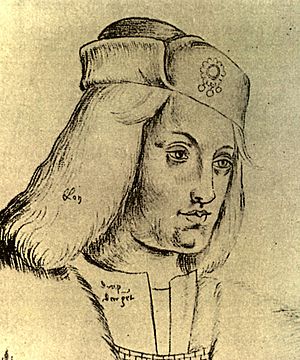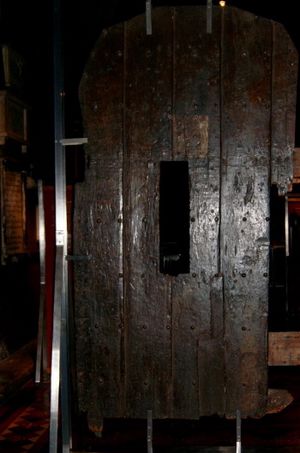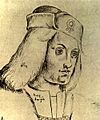James Ormond (administrator) facts for kids
Quick facts for kids
Sir James Ormond
|
|
|---|---|
| Died | 17 July 1497 Kilkenny, Ireland |
| Father | John Butler, 6th Earl of Ormond |
| Mother | Reynalda O'Brien |
Sir James Ormond, also known as Butler, was an important figure in Irish history. He was the son of John Butler, the 6th Earl of Ormond. From 1492 to 1494, he served as the Lord Treasurer of Ireland. In this role, he helped protect Ireland from the forces of Perkin Warbeck, who claimed to be a prince. Sir James Ormond was killed by Sir Piers Butler on July 17, 1497. Piers Butler later became the Earl of Ormond.
Contents
Sir James Ormond's Family
James Ormond was the oldest of three sons. His father was John Butler, 6th Earl of Ormond, who passed away in 1476. His mother was Reynalda O'Brien, whose father was Turlogh "The Brown" O'Brien, the King of Thomond.
One of James's younger brothers was John Ormond. In 1458, John married Joan Chaworth. They had three daughters together. Not much is known about James's other younger brother, Edward Ormond, except his name.
James and his brother John were born in Alfreton, England. Their grandfather was Turlogh "The Brown" O'Brien, who was an Irish King.
His Important Career


Sir James Ormond likely grew up at the royal court. His uncle, Thomas Butler, 7th Earl of Ormond, helped raise him. In 1486, James joined a famous legal school called Lincoln's Inn.
In 1487, his uncle appointed him as his helper in Ireland. This happened after another Sir James Butler died. However, the son of the deceased, Sir Piers Butler, disagreed with this appointment.
Defending Ireland
In 1491, King Henry VII of England sent Ormond to Ireland. He went with 200 soldiers to protect the King's interests. This was against Perkin Warbeck, who pretended to be a prince. Ormond was made Governor of both Kilkenny and Tipperary.
By June 1492, Ormond became one of King Henry VII's advisors. He then took over as Lord High Treasurer of Ireland. He and the Archbishop of Dublin, Walter Fitzsimons, became joint governors of Ireland. They replaced Gerald FitzGerald, 8th Earl of Kildare.
Making Peace
The King's decision to remove the Earl of Kildare caused problems. It made an old rivalry between the Butler and FitzGerald families worse. But in the summer of 1493, Ormond and Kildare made peace. This happened in St Patrick's Cathedral, Dublin. Ormond had sought safety there. They shook hands through a special hole cut in the chapter house door. This is now known as the 'door of reconciliation'.
Royal Appointments
To stop another invasion by Perkin Warbeck, King Henry VII sent more soldiers to Ireland. In September 1493, Viscount Gormanston replaced Ormond and Fitzsimons as governors. Ormond and other Irish officials spent the winter of 1493 in England. They were preparing to defend Ireland against Warbeck.
Sir James Ormond was replaced as Lord Treasurer. But the King gave him several estates as a reward. He returned to Ireland in June 1494. He was made Constable of Limerick Castle. He worked closely with Sir Edward Poynings, a new Deputy Lieutenant. They went on a trip to Ulster together in November 1494.
In February 1495, the Earl of Kildare was arrested for treason. His brother took over Carlow Castle. Poynings and Ormond attacked the castle in the spring. They took it back in July. Warbeck and Desmond then attacked Waterford. Ormond brought troops to Waterford. Soon after, Warbeck's support in Ireland disappeared.
Sir Edward Poynings was called back to England. Most of his soldiers went with him. Because of this, Ormond took on a bigger role in Irish military matters.
Final Years and Death
In 1496, King Henry VII decided to make the Earl of Kildare Governor again. Ormond was called to England in July for a formal peace meeting. This meeting was between the Earl of Ormond and the Earl of Kildare.
The English troops Ormond had led were sent back to England. Kildare seemed to favor Ormond's rival, Piers Butler. Butler claimed that Ormond was saying he was the rightful Earl of Ormond. He also said Ormond was secretly working with Perkin Warbeck.
These claims made King Henry VII summon Ormond to England in early 1497 and again in May. However, Ormond did not go to either meeting. He was killed by his rival, Sir Piers Butler, on July 17, 1497. This happened in a sudden fight near Kilkenny.
Sir James Ormond was knighted in 1493 by King Henry VII of England. This was for his service in battle for the Tudor family. He owned land in Wiltshire, England. The year before he died, King Henry VII made him an Irish peer. The Irish people called him the Earl of Ormond, but he never officially held that title.
Images for kids



